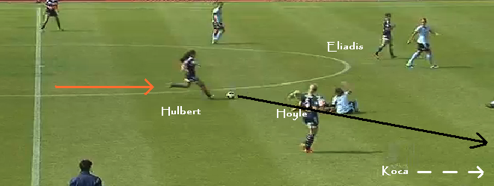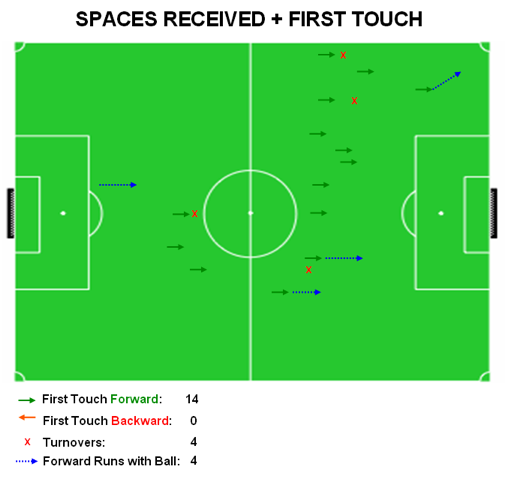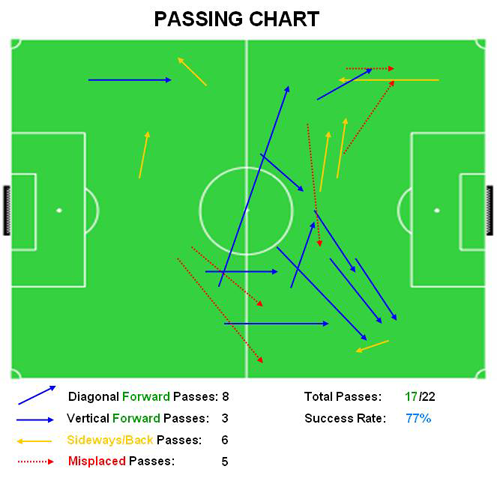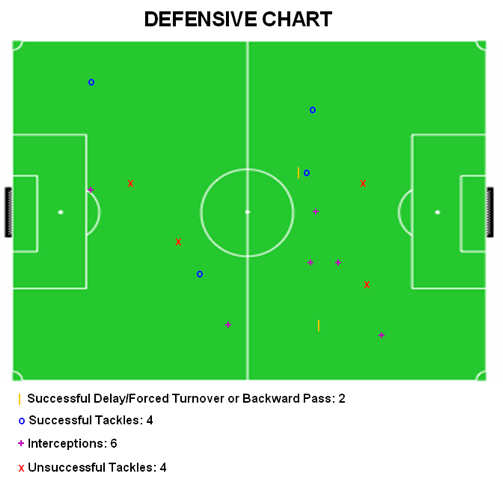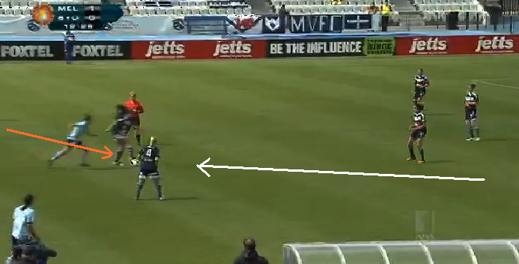It takes a brave coach to start with two seventeen year olds against the defending champions. It takes an extremely courageous one to play two teenagers in the middle of the park in such an important game. New Melbourne Victory coach Dave Edmondson threw caution to the wind on Sunday against Sydney FC, handing starts to Tiffany Eliadis and Emily Hulbert in a new look midfield. Mind you, one is the reigning Women’s Premier League Gold Medalist while the other is a rising star in Victoria so it wasn’t exactly a harebrained ploy.
While the blowout loss was ultimately a disappointing result, it’s always important to highlight the positive aspects which can sometimes be lost amidst the confusion and heartache of a heavy loss. One of those postitives on the weekend was the encouraging performance from young Hulbert on debut.
Although she would have been disappointed to be replaced at half time by the more experienced Enza Barilla, the teenager’s first outing gave reason to believe that she has the potential to be a vital cog in what could still turn out to be a strong W-League campaign for Victory. Fans would do well to remember last season’s consecutive losses to Perth and Brisbane, and the strong run to the Grand Final as things started to click.
Hulbert’s first W-League start came on the back of an eye-catching cameo in Melbourne Victory’s one and only preseason game the previous Saturday. The young starlet from Monbulk was thrown on at half time in a fighting 0-0 friendly draw against the WPL All-Stars and looked to have done enough to convince Edmondson of her qualities.
Sunday saw her line up alongside New Zealand international Katie Hoyle in the Victory engine room as the team looked to avenge their Grand Final defeat earlier this year. Despite only recently returning to full fitness after a long injury layoff with WPL club Box Hill United, Hulbert was handy on the ball and full of attacking intent as she looked to encourage her team to advance upfield whenever possible.
A step in the right direction
Hulbert didn’t carry the ball all that much but her first touch never once went backwards. The majority of her possessions came from her ability to read play well and intercept or pick up loose balls and there was a remarkably thin band across the pitch where she took most of her touches.
As Edmondson’s team looked to press high, Hulbert was often the beneficiary of loose Sydney passes out from the back, cleverly reading and stepping ahead of opposition midfielders to pinch the ball.
Her most common action (as seen in the image above) during her forty five minutes of play was to receive or pick up a loose ball just ahead of the halfway line, take a positive first touch and play a short pass, usually to the feet of a teammate, to keep Victory ticking.
It was rare for her to turn the ball over and only once did this occur in the defensive half and even then in an area that posed little danger to Melbourne’s back four. The only regret is that she didn’t pick the ball up more but with confidence and experience, that hunger to receive the ball will only increase.
Hulbert’s preference for short, crisp passes helped Melbourne retain possession which they started to struggle with after Sydney drew level. Again, the only gripe is that she didn’t have that many touches and therefore didn’t give herself the opportunity to further stamp her authority on the match. Only two misplaced passes in her defensive half (bear in mind that those passes left her boot in the defensive half but both traveled over the halfway line before being intercepted), show a penchant for protecting the ball when required.
A possible issue for the young midfielder to rectify is that almost all of her passes started and ended in the middle third of the ground. The one time that she was in possession in the attacking third, she passed the ball backwards. With such a great deal of confidence in her first touch and positioning, it would be great to see Hulbert attempting more penetrating, key passes into the final third and look to help lighten the creative load on Eliadis’ shoulders by providing the forward three with more goalscoring opportunities.
As previously mentioned, the teenager’s positioning belies her age and relative lack of top-flight experience. Hulbert’s greatest contribution came in the form of interceptions and collection of free balls. She was also able to identify the moments that Hoyle left her deep position to aid in the Victory’s high press and dropped in smartly to cover her experienced teammate.
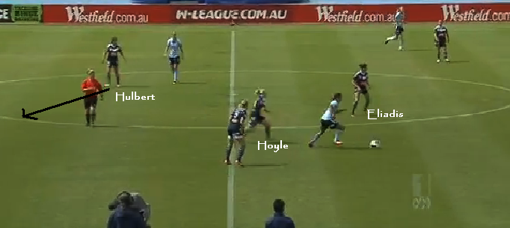
This allowed a more aggressive Hoyle to help disrupt Sydney’s play slightly higher and was the precursor for many of Hulbert’s best moments in the first half as the Sky Blues were forced into errors and the youngster pounced from a deeper position to set the Victory’s attack in motion.
That being said, Hulbert was often timid in her defensive half and although usually positioned well in relation to the ball and her direct opponent, at times was not close enough to make a telling defensive impact or force an error from Sydney’s skillful attacking midfielders. This could almost certainly be put down to the fact that she is still working her way to peak condition following an ankle injury that saw her miss several weeks of football until her return in the latter stages of the WPL season.
There is work to do yet, but all the signs are that this girl can certainly play. Melbourne Victory should be relatively pleased with Emily Hulbert’s starting debut and with some tighter defensive work and more penetrative passing, her intelligent football brain and excellent first touch could become a crucial component in Dave Edmondson’s midfield as the season progresses.


